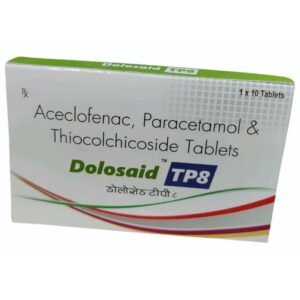ACECLOFENAC + PARACETAMOL + THIOCOLCHICOSIDE
Aceclofenac: Aceclofenac is a nonsteroidal anti-inflammatory drug (NSAID) that is used to reduce pain and inflammation in conditions such as rheumatoid arthritis, osteoarthritis, ankylosing spondylitis, and other musculoskeletal disorders.
The mechanism of action of Aceclofenac is by inhibiting the synthesis of prostaglandins, which are responsible for pain, inflammation, and fever. It selectively inhibits the enzyme cyclooxygenase-2 (COX-2), which is involved in the production of prostaglandins.
The usual dose of Aceclofenac is 100 mg to 200 mg per day, taken in divided doses. The tablets should be taken with food or milk to minimize stomach upset.
Common side effects of Aceclofenac include stomach pain, indigestion, nausea, diarrhea, headache, dizziness, and rash. It may also cause gastrointestinal bleeding and ulceration, particularly in higher doses or with long-term use. Like other NSAIDs, Aceclofenac can also increase the risk of cardiovascular events such as heart attack or stroke, especially when used at higher doses or for an extended period.
Aceclofenac should be used with caution in patients with a history of gastrointestinal disorders, cardiovascular disease, or kidney or liver impairment. It is contraindicated in patients with a known hypersensitivity to NSAIDs or those who have experienced allergic reactions (such as asthma, rhinitis, or urticaria) to aspirin or other NSAIDs.
As with any medication, it is important to consult with a healthcare professional or read the package insert for complete and up-to-date information about Aceclofenac, including its contraindications, precautions, and drug interactions.
Paracetamol: Paracetamol, also known as acetaminophen, is a widely used medication for relieving pain and reducing fever. It is considered a first-line treatment for mild to moderate pain and is commonly used for headaches, menstrual cramps, toothaches, muscle aches, and cold/flu symptoms.
The exact mechanism of action of Paracetamol is not fully understood, but it is believed to work by inhibiting the synthesis of prostaglandins, which are substances in the body that contribute to pain and fever. Paracetamol is thought to primarily act on the central nervous system, rather than directly on the peripheral tissues.
The usual adult dose of Paracetamol is 325-1000 mg taken every 4-6 hours, up to a maximum daily dose of 4000 mg. The recommended maximum daily dose may be lower for individuals with certain conditions, such as liver disease, and it is important to follow the instructions given by a healthcare professional or adhere to the recommended dosing information on the packaging.
Despite being generally safe when used appropriately, Paracetamol can have side effects in some individuals. Common side effects include nausea, upset stomach, and rash. Serious side effects, although rare, can occur, especially if the maximum daily dose is exceeded. These can include liver toxicity, which can be life-threatening. It is essential to consult a healthcare professional if any unusual or severe side effects occur.
It is crucial to note that Paracetamol should not be used in combination with alcohol, as it increases the risk of liver damage. It is also important to check for other medications that contain Paracetamol to avoid accidental overdose.
Overall, Paracetamol is a widely available and effective medication for relieving pain and reducing fever. However, it’s essential to use it responsibly and follow the recommended dosage guidelines to avoid any potential side effects or complications. Always consult a healthcare professional or pharmacist if you have any concerns or questions about its use.
Thiocolchicoside: Thiocolchicoside is a muscle relaxant drug that is used to treat muscle stiffness and spasms. It is commonly prescribed for conditions such as muscle sprains, strains, and muscular pain. Thiocolchicoside works by acting on the nervous system to decrease the excessive muscle contraction and restore muscle tone.
The exact mechanism of action is not fully understood, but it is believed to involve a dual action. Firstly, Thiocolchicoside inhibits the release of certain substances in the brain and spinal cord that are responsible for transmitting pain signals. This action helps to reduce the perception of pain associated with muscle spasms. Secondly, Thiocolchicoside directly acts on muscle fibers, causing relaxation and relieving muscle stiffness.
The recommended dose of Thiocolchicoside usually ranges from 4 to 8 mg per day, divided into two or three doses. The dosage may vary depending on the severity of the condition and the individual response to the drug. It is usually taken orally as tablets or capsules, preferably with food to minimize the risk of stomach upset.
Like any medication, Thiocolchicoside can cause some side effects. Common side effects include drowsiness, dizziness, headache, stomach upset, and nausea. These side effects are usually mild and temporary. However, if they persist or worsen, it is advisable to consult a healthcare professional. In some cases, allergic reactions may occur, characterized by rash, itching, swelling, severe dizziness, or difficulty breathing. If any of these symptoms occur, immediate medical attention should be sought.
Thiocolchicoside may interact with certain medications, so it is important to inform your healthcare provider about all the medications you are taking, including prescription, over-the-counter, and herbal supplements. It should not be used by individuals with a history of allergy to colchicine or colchicum plants, or those with severe liver or kidney impairment.
Overall, Thiocolchicoside is a muscle relaxant that can effectively relieve muscle stiffness and spasms. However, it is important to use it as prescribed and under the supervision of a healthcare professional to minimize the risk of side effects and ensure its safe and effective use.

